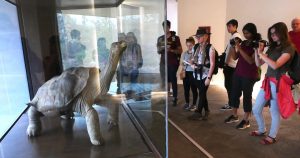Day 21: There Are No Words
We all have our own reasons for being here, on this dialogue that is. Additionally, we all bring our own skillset, our own education, and our own perspective to the group. We encompass an excruciatingly wide range of differences including varying degrees of experience in Spanish. However, if I had to pick one tidbit to unite us, one commonality that threads all 15 of us together (outside of this adventure) it would be our anticipation for the Galapagos Islands.
From the beginning the first thing that would sprout in our heads when we gossiped and squealed over this trip was the Galapagos. It is more often than not our point of reference when we first think of Ecuador. Why wouldn’t it be? Charles Darwin’s On the Origin of Species was a turning point for science. Most of our student body here is made up of scientists, but even those outside of the field knows who Charles Darwin is. Sure Quito is phenomenal, but at first who knew how to spell Otavalo? Or where on earth Cotacachi was. The Galapagos Islands were at the forefront of our minds and now that we’re here the hazy image of what these islands could be has solidified and exposed us to the world it actually is. The world that unbeknown to us could in no way match what we expected.
The first half of our day was spent traveling. It was a blur of bus, plane, and boat. The plane stopped in Guayaquil for a ‘layover’. I put layover in quotations because I don’t know if it is fair to call it such. The plane did stop at the airport, but we did not leave the plane. Rather some passengers unloaded, some were boarded, and 40 minutes later we were off to Baltra. From Baltra we went through a tonne of security. Because much of the Islands are used for environmental conservation efforts, the airports are very diligent about what organic material comes in and out of the Islands. The smallest intrusion could wreck the ecosystem (for some info and background check out RadioLab’s episode on the Galapagos Islands). Getting off the plane in itself is an experience. The land looked a bit like the planes of Australia. However, once we were out, it was lush greens, ocean air, and most importantly SUN (followed by flickering rain). We took a boat through the bay and ended up on another bus that would take us to our hotel. The day is half over at this point however, as has become the norm, there are always a few more items on our agenda.
Priority number 1: Going to see some tortoises. Straight after lunch, with only 1 hour until closing time we went to the Charles Darwin Research Station. Our guide Julie gave us a glimpse of the kind of wildlife and fauna Santa Cruz had to offer. We were completely and utterly enthralled by the sheer size and existence of turtles, the height and unique characteristics of the poison apple tree, plus some of the methodology and research that goes into conservation. We transformed into the atypical tourist with all our questions, our ‘oooohing’ and ‘ahhhing’ plus the whipping out the camera at every moment didn’t help.
Priority number 2: though I am a bit biased here and it could be considered an extension of priority number 1, Lonesome George: the last Pinta Island Tortoise. Probably one of the rarest animals in the world, Lonesome George was the last of his kind and stands at the Research center as a beacon of hope. Pinta Island tortoises were thought to be extinct way back when due to hunting, however when Lonesome George was found we had hope. Although he died in 2012, he stands as a reminder as to why we aspire to preserve and support our wildlife.

Needless to say, we packed a lot in that one hour. It was an hour well spent and we’ll definitely be back later.